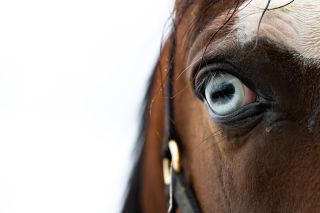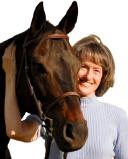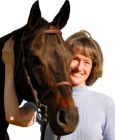Animal Behavior
How Horses See the World
For starters, vision may not even be their primary sense.
Posted July 12, 2023 Reviewed by Lybi Ma

Imagine you are riding a huge horse, strong and powerful. The two of you are still, looking out onto some view of the world while standing in one place. Facing the same scene, does the horse see what you see?
In a word? No. Not by a long shot.
Vision is the foundation for my efforts to explain cross-species brain differences to people. Vision is our primary sense. In fact, almost one-third of the human brain is devoted to vision, and more real estate than any other human sense is allowed. Horses, on the other hand, rely on outstanding senses of smell and touch. But because vision is primary for humans, we assume it is primary for other animals as well.
In terms of vision, the most obvious difference between you and that horse you’re sitting on is the horizontal range of view. The horse’s eyes are set on the sides of her head, a hallmark of the prey animal. This means that without moving her eyes, she can see objects in a 340-degree range, all the way around both sides of her body to the edges of her hips. You see a 90-degree range without moving your eyes.
Prey brains are designed to detect motion very quickly. Why? Well, to avoid being eaten! If the grass sways a little bit in the absence of a breeze, the horse needs to run before the lion begins to chase. Motion detector cells in mammalian brains are specialized to pick up certain speeds and the direction of motion. The horse’s eyes and brain are more sensitive to tiny movements at high speeds than ours are.
Horses also have the ability to see dim outlines in the dark. Their “night vision” is nowhere as good as most humans think it is, but on a moonless night, they’re not swimming in a bottle of India ink like we are.
Horizontal range, motion detection, and night vision lead many people to believe that equine sight is superior to human sight—that the horse can see pretty much anything anywhere at any time. But there are many other aspects of eyesight to consider. Depth perception, light adaptation, dark adaptation, acuity, focus, color vision, frontal vision, and vertical range of view are all much worse in horses than in humans.
What I see is not the same as what my horse sees, even when we are both looking at exactly the same view. The horse galloping down to jump over a huge wall sees a different obstacle than her rider does. And the horse cutting cows or pulling a carriage or running around her pasture sees the environment differently than we do, too. Imagine a sport in which your equipment has a mind of its own and that mind doesn’t represent the world the way yours does.
Contrary to popular myths, horses have many blind spots. They can’t see anything below their bellies, around their enormous feet, above their eyeballs, below their eyeballs, under their eyes out to about six feet in front of their faces, behind their hips or hind legs, or above their necks and backs. Because horses are so big, many of these blind spots are large enough to hide a child, dog, or adult. Of course, the horse can smell us if we are near, but that alone doesn’t specify exactly what part of her body we are near. To signify location, we use our hands and voices—to give the horse something to hear and feel so she knows where we are.
These disparities in vision teach us to handle horses with greater safety and cooperation. But, more important, they show us that different minds operate in different ways, and not just between prey and predator species. Apply the lesson to humans of different ages, backgrounds, eye colors, visual function, and cultures, and you’ll get a better idea of how hard it is to achieve similar perceptions of the world—both literally and metaphorically.
Facebook/LinkedIn image: cctm/Shutterstock


